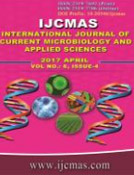


 National Academy of Agricultural Sciences (NAAS)
National Academy of Agricultural Sciences (NAAS)

|
PRINT ISSN : 2319-7692
Online ISSN : 2319-7706 Issues : 12 per year Publisher : Excellent Publishers Email : editorijcmas@gmail.com / submit@ijcmas.com Editor-in-chief: Dr.M.Prakash Index Copernicus ICV 2018: 95.39 NAAS RATING 2020: 5.38 |
Cluster bean [Cyamopsis tetragonoloba (L.) Taub] popularly known as “Guar” is an important legume crop mainly grown under rain fed condition in arid and semi-regions of Rajasthan during kharif season. It is very hardy and drought tolerant crop. Its deep penetrating roots enable the plant to utilize available moisture more efficiently and thus offer better scope for rain fed cropping. It has high calorific and nutritive value and its seed contains 28-32% of gum. Nitrogen also plays an important role in synthesis of chlorophyll and amino acid, which contributes to the building units of protein and thus the growth of plants. Insufficient nitrogen may reduce yield drastically and deteriorates the quality of produce. Cluster bean being a legume crop which has the capacity to fix atmospheric nitrogen by its effective root nodules the major part of nitrogen is met through Rhizobium present in the root nodules. The experiment was laid out in Randomized Block Design with three replications. The experiment consisted of three level of Nitrogen (20, 15 and 10kg/ha), Phosphorus (40, 30 and 20kg/ha) and Potash (20, 15 and 10kg/ha) in combination with Phosphorus Solubilizing Bacteria (PSB) and application of Zinc at 5 kg/ha. Cluster bean variety RGC-1003 was sown at 15 kg ha-1 at 45 cm x 20 cm spacing on 22 July 2014. Application of Nitrogen 20,Phosphorus 40 and Potash 20kg/ha in combination with Phosphorus Solubilizing Bacteria and Zinc at 5kg/ha recorded maximum plant height, more number of branches, more number of nodules, maximum plant dry weight, Thus availability of native and applied phosphorus increased in root zone for utilization by the plant for growth and nodulation.
 |
 |
 |
 |
 |